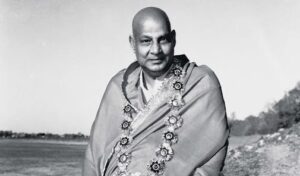Did you know that there are many different ways to practice meditation? One type of meditation technique is called mantra japa, or repetition of a mantram—a sound structure of one or more syllables which represents a particular aspect of the divine vibration. In the Integral Yoga tradition, it is possible to take mantra initiation and receive a mantra with which to use in meditation. Swami Asokananda, one of Integral Yoga’s foremost teachers, shares his experience with the practice of mantra japa, its benefits, and how he stays supported and inspired in his spiritual practice.

A mantra japa practitioner counts repetitions with a mala (prayer beads).
You’re leading an upcoming workshop at Yogaville, Mantra Initiates Reunion. The last time you were featured on the blog, you shared your story about first meeting Gurudev, how you got involved in Integral Yoga, and your decision to take mantra initiation.
How long have you been practicing mantra japa (mantra repetition as a meditation technique) and how has it benefited you?
In this lifetime, I would say I started around the age of 19 practicing mantra japa. I was living at the Integral Yoga Institute in Hartford, Connecticut, and I started using the Hari OM mantra. Then I read The Gospel of Sri Ramakrishna, which had a tremendous impact on me. Sri Ramakrishna talked about the importance for a spiritual seeker to receive a mantra from an enlightened being. So I wrote to Gurudev—which I had never done before—and I asked if it was proper for me to request a mantra from him, without knowing if he was my guru or not.
Shortly afterwards, I got a message to call him. I was quite nervous to be on the phone with him, but he immediately put me at ease. He said how much he appreciated my question; many people just take the mantra and they don’t make the connection between the mantra and the Guru-disciple relationship. Then I asked, “They say when the student is ready, the teacher appears. I don’t know if I’m ready and you’re appearing or if I am pushing something that I’m not quite ready for. Am I ready or not?”
I’ll always remember his answer. I use it for all the important decisions in my life. He said: “The mind has no light of its own. Like the moon, it just has a reflective light. But there is a Sun in you; the Source of Light. Wait until you receive the guidance from this Sun.”
“How will I know the guidance I’m receiving is from the Sun?” I asked.
“When the Sun guides you, it will be clear,” he reassured me.
The months went by without feeling any communication from the Sun. I wondered: Maybe I don’t have a Sun. Or maybe I’m receiving the guidance by the absence of communication—I’m not supposed to get initiated. After a while, I the question about initiation faded from my mind.
But then it happened, just like Gurudev said. I was at a kirtan, clapping blissfully, and I received the totally unambiguous message: Sri Swami Satchidananda is your guru—take initiation!
It took about another half a year before Gurudev was giving initiation. In the meantime, I was repeating the mantra Hari Om. I developed a heartfelt connection to Hari OM. I started to have a doubt: Was I betraying my loyalty to Hari Om? Do I really need another mantra?
But it felt like this confusion was coming because the moon was obscuring the Sun. I knew that I needed to proceed and submit myself to the Guru and receive his mantra.
When the moment of the initiation took place, everything fell perfectly into place. I could feel Hari Om respectfully bow to me and then merge with the new mantra. I knew that all the benefit that had accumulated from my previous practice was immediately transferred to my “new account.” For me and my new mantra, it was love at first repetition.
And over the next 45 years I couldn’t ask for a better best friend. As I travel the world, I carry my luggage in one hand and hold Gurudev’s hand with my other hand, with the mantra reverberating through my system. And I feel at home wherever I am.
I keep it going as much as possible through the day, but I do have my 3 formal sittings—my morning, noon, and evening meditation—where I solely focus on mantra japa. I have no idea about all the benefits that I’m receiving, but I do know the practice has changed my life in a dramatic way. Who knows where I would have ended up? I used to be an anxious person with social phobias. These neuroses affected my immune system; my health wasn’t that great. My connection to the Guru and the mantra has given my life purpose and meaning that I was missing.
One cautionary note: while mantra initiation will bring many benefits, it will also speed up one’s karma. Taking initiation is a sign of the soul’s sincerity for spiritual growth. It’s an important juncture in the soul’s journey. That commitment to grow can actually make things more turbulent in your life. I have a friend who took many years before she decided she was ready for initiation. When she decided to take it, she was really ready for it. But she called me 6 months after the initiation and said, “I have to stop repeating the mantra! My life has fallen apart, my career, my relationships, financially, everything!” I said, “Well, rather than cutting the mantra completely out of your life, how about doing just 3 repetitions a day? You can do the 3 at once or one repetition at various times.” She said, “That I can do.” Six months later she called me and said, “Life is good! Things have really transformed.” Mantra initiation is like Shiva is the destroyer. It clears the ground for something new to grow.
So, having a Guru or a mantra will not remove the challenges we have to face in life. But they will give us a strength that is beyond ego strength. It is strength with a capital S and love with a capital L. It is not the love that comes and goes and causes pain.
In my travels I meet many people who have taken initiation, but feel that they’re on their own, without support. There is no Integral Yoga community nearby. So I’ve been thinking for a while about how to serve these spiritual brothers and sisters, to re-inspire them to keep their practice strong. That is what I hope this Initiates weekend will accomplish.

Sangha is a spiritual community that supports you on your spiritual journey.
Would you say then that sangha (spiritual community) is a big support on the journey?
I do think so. The Buddha listed 3 important things for one’s spiritual growth: find the right teacher, find the right teaching, and find the right sangha. I moved into the New York Integral Yoga Institute when I was 19; at 66 I still feel that I don’t want to do this on my own. I do see that with the right support, people can flourish, and without it, many people flounder. I’ve never tested it myself, because I never wanted to tread this path on my own. For most of us, sangha is crucial.
In addition to sangha, are their other ways you get re-inspired? Do you find new ways to stay motivated in your spiritual practice, or do you find that sangha is enough?
Yeah, sangha may not be enough (laughs). In the end, you have to leave the people around you, go to your own room, and sit with your mind. Sangha will help to bring out the better samskaras (impressions), but in the privacy of your room, who knows what will come up. Your mind may not be supportive sangha. So sangha can help, but it may not be enough. You need to have some discipline to your life. You don’t have to do a lot of practice, but you have to have a regular practice. I think practice also improves with daily svadhaya (spiritual study). It is important to have a connection with the teachings of beings further down the line than you. Ideally, those beings have gone all the way down the path to enlightenment.
The primary responsibility in my life is to not get complacent in my spiritual practice—to keep it alive, to keep it from getting rote. There will be days when my practice is not very inspired, but I don’t judge it anymore. My job is to keep my aspiration sincere and to use my life experience to keep learning lessons—the main lesson being that happiness isn’t going to come from outside. My happiness isn’t even going to come from my Yoga practice; it’s going to come from recognizing what’s already there. My Yoga practice will help to stop disturbing that.
I keep learning about how to make use of mantra japa; it’s not a stagnant thing for me. I used to always do mental repetition, which is the most powerful if the mind can stay focused. But if I find that my mind is not that focused, I’ll vary between mental repetition of the mantra and repeating it silently with lip movement. I’ve experimented with this and I see I can stay a little more on top of my mind if I’m moving my lips. These are things I still play around with and discover. I like the fact that my practice isn’t stagnant.
I want meditation to be an enjoyable part of my life. If a practice is not enjoyable you might stick with it, but your heart will not be in it. We want to practice in such a way that we look forward to it. The problem is, that takes time. In the beginning years, you may not find it that enjoyable. It’s hard work to stay on top of what the mind is doing. Personally, I don’t try to stop the thoughts anymore. I try to be aware of what the mind is doing, and then let it go without suppression. Even after all these years I don’t say that it’s easy, but it’s a fascinating process. And I see that it’s really important for me to give the mind a break from being caught up in the worldly level and to remember that there are other realms that are worth pursuing.
So there are a few things other than sangha that will be helpful. Discipline, sincerity, and svadhaya are also crucial.

Master Sivananda, Swami Satchidananda’s guru.
In the description for your upcoming program, you give this quote: “The glory of the name of God cannot be established through reasoning and intellect. It can certainly be experienced or realized, only through devotion, faith, and constant repetition.”—Master Sivananda
Can you elaborate on what it means and how it might apply to mantra japa?
To me, the mantra is divine. You won’t be able to get past the doorway to the divine through the intellect, through the buddhi. It can only take us so far. The intellect is very subtle, but it’s stll too gross to really grasp the subtlety of what the mantra is. We need to purify the buddhi; it can lead us toward the Light. Then we need to drop it and put the faith in something even beyond the intellect. Your reasoning and intelligence will not be useful at that point. I’m not saying that mantra is the only way, but for me it’s the way, and it’s the way that Gurudev has given us. You open your heart and begin to recognize the power inherent in this sacred vibration. That’s the beauty of mantra repetition: you don’t need to have tremendous intelligence. You can realize everything with average intelligence—which is helpful for someone like me (laughs)—by your simple, sincere faith. It is hard for Westerners, and probably for Easterners, too, to let go of the intelligence and recognize that it has taken us far, but now we need to use another aspect of our being if we’re going to go any further.
So I find that quote to be very true. For me, Master Sivanandaji is pointing me to the end goal of mantra japa. There comes a time when the external part of the mantra falls away like the husk of a seed. You get impregnated by the internal seed of the mantra and the true glory of the name of God is born in you.



